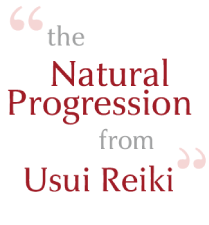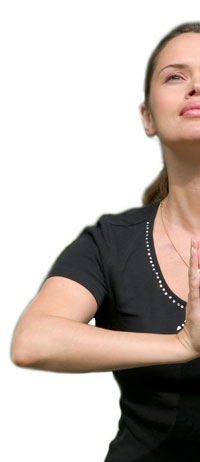
What is Reiki?
Reiki treatments
The meaning of Reiki
The word 'Reiki'
The system of Reiki
Shoden Level I (Japanese: Beginner Teachings)
Okuden Level II (Japanese: Hidden or Inner Teachings)
Shinpiden Level III (Japanese: Mystery Teachings)
The Five Elements
The word Reiki can be translated from the Japanese to mean ‘Spiritual Energy’. The word refers to energy rather than a system or teachings.
A Reiki Practitioner who studies the system of Reiki is taught methods that were developed by the founder Mikao Usui in the early 1900s that utilize ‘Reiki’ to heal the self and become whole.
Influences upon Mikao Usui (1865-1926), and consequently upon his teachings (which are known as the system of Reiki today), came from his Japanese martial arts practice, Shintoism (the traditional Japanese folk religion), Japanese Buddhism (namely Tendai), and Shugendo (a spiritual mountain practice). Naturally the Japanese culture and philosophy that was apparent during Mikao Usui’s lifetime was also a great influence upon what has developed as the system of Reiki.
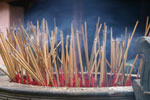
![]() A Reiki treatment is approximately one-hour long and is useful for specific healing or general relaxation. The client remains fully clothed at all times as the Reiki Practitioner goes through a set healing process placing hands on, or just off, the body as agreed with the client prior to the Reiki treatment. Gender, age and condition are of no concern as the client’s own body controls this energetic process. During the Reiki treatment the body will only take the amount of energy that it requires. A Reiki treatment is not intrusive and clients do not remove clothing and no private parts of the body are touched. If a client is wishing to work on a specific issue or health problem it is advisable to book for three one-hour Reiki treatments. Naturally one Reiki treatment can be taken at any time for relaxation, healing or simply to try it out.
A Reiki treatment is approximately one-hour long and is useful for specific healing or general relaxation. The client remains fully clothed at all times as the Reiki Practitioner goes through a set healing process placing hands on, or just off, the body as agreed with the client prior to the Reiki treatment. Gender, age and condition are of no concern as the client’s own body controls this energetic process. During the Reiki treatment the body will only take the amount of energy that it requires. A Reiki treatment is not intrusive and clients do not remove clothing and no private parts of the body are touched. If a client is wishing to work on a specific issue or health problem it is advisable to book for three one-hour Reiki treatments. Naturally one Reiki treatment can be taken at any time for relaxation, healing or simply to try it out.
Everything has energy or ‘ki’ in it – even a piece of paper or a plant, every item in the room, the building itself, the city, the country, the world, the universe and on and on. There is an unlimited amount of energy. This energy may seem invisible or elusive but it is, in fact, all encompassing. It is this energy that makes, not just humans, but worlds function. It is the fuel that drives humans and gives ultimate structure and purpose in life. This is Reiki. It is the energy of everything. It us neither a religion nor is it intrusive.
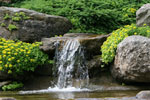
![]() If we already have energy or ki, why do we need the practise of Reiki? To help understand, envision a free-flowing river. This beautiful river is like energy flowing easily down through the body. Occasionally a pebble, or even a rock, will fall into that river, making the flow of the water a little more difficult. These pebbles are human worries, fear, anger, and each pebble builds on top of the other. Soon there is only a trickle of water running in that once beautiful free-flowing river. And so it is with energy in the human body. Energy flow can be obstructed so much that at this point physical pain may be experienced.
If we already have energy or ki, why do we need the practise of Reiki? To help understand, envision a free-flowing river. This beautiful river is like energy flowing easily down through the body. Occasionally a pebble, or even a rock, will fall into that river, making the flow of the water a little more difficult. These pebbles are human worries, fear, anger, and each pebble builds on top of the other. Soon there is only a trickle of water running in that once beautiful free-flowing river. And so it is with energy in the human body. Energy flow can be obstructed so much that at this point physical pain may be experienced.
During a Reiki treatment the pure flow of energy is re-aligned within the body. It washes down, clearing obstructions and strengthening the flow of energy. This not only helps us feel physically better, but it allows us to feel a connection to the understanding of one’s purpose on Earth and the most effective way of achieving it.
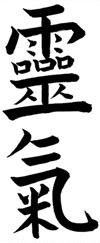 Reiki, the word, is Japanese. It is written with two Japanese kanji, meaning ‘Spiritual Energy’.
Reiki, the word, is Japanese. It is written with two Japanese kanji, meaning ‘Spiritual Energy’.
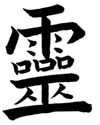
![]() is rei (lit. Japanese) spiritual
is rei (lit. Japanese) spiritual
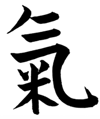
![]() is ki (lit. Japanese) energy
is ki (lit. Japanese) energy
Previously these two kanji have been translated as ‘Universal Energy’ (or Universal Life Force Energy) outside of Japan. This is a translation of the second kanji, ‘ki’, only. The concept of ki is naturally the energy of everything including Heaven and Earth, the entire universe.
The first kanji, ‘rei’, may have been left out of English translations due to the fact that the term ‘spiritual’ was not the focus of the modern practise.
In Chinese, the same two kanji used to represent Reiki are pronounced differently but have similar meaning. In Chinese, Reiki is called Ling chi.
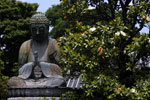
![]() The word ‘Reiki’ is also used today to represent a healing system.
The word ‘Reiki’ is also used today to represent a healing system.
Mikao Usui, the founder of the system of Reiki, did not call his teachings by this name. ‘Reiki’ appeared written in conjunction with his teachings but this was merely to point out that the teachings worked with spiritual energy.
‘Reiki’, the word, can be found in the branches of schools that developed from Usui Mikao’s teachings. Both the Usui Reiki Ryoho Gakkai (Society of the Usui Spiritual Energy Healing method) and Hayashi Reiki Kenkyu Kai (Hayashi’s Spiritual Energy Research Society) use the word ‘Reiki’ to signify ‘spiritual energy’, but neither actually called the system ‘Reiki’.
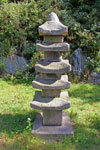
![]() Hawayo Takata was the first student of these teachings outside of Japan. Hayashi Churjiro, her teacher, came with her to Hawaii to help her set up her practice. At his farewell dinner in 1938, he presentation her with a Western-style certificate. This official gesture ensured that she was viewed as a legal teacher and practitioner in these teaching under American law. The certificate states in English that Hawayo Takata ‘has passed all the tests and proved worthy and capable of administering the treatment and of conferring the power of Reiki on others’. This appears to refer to the word Reiki as meaning ‘spiritual energy’ rather than the name of a system. The certificate also states in English that she was a ‘Master of the Usui Reiki system of drugless healing’. Here the work ‘system’ appears to have been translated from the Japanese word ‘Ryoho’ while the word ‘Reiki’ has been left as is. In neither instance does the certificate convey that the system was called ‘Reiki’ by Hayashi Churjiro.
Hawayo Takata was the first student of these teachings outside of Japan. Hayashi Churjiro, her teacher, came with her to Hawaii to help her set up her practice. At his farewell dinner in 1938, he presentation her with a Western-style certificate. This official gesture ensured that she was viewed as a legal teacher and practitioner in these teaching under American law. The certificate states in English that Hawayo Takata ‘has passed all the tests and proved worthy and capable of administering the treatment and of conferring the power of Reiki on others’. This appears to refer to the word Reiki as meaning ‘spiritual energy’ rather than the name of a system. The certificate also states in English that she was a ‘Master of the Usui Reiki system of drugless healing’. Here the work ‘system’ appears to have been translated from the Japanese word ‘Ryoho’ while the word ‘Reiki’ has been left as is. In neither instance does the certificate convey that the system was called ‘Reiki’ by Hayashi Churjiro.
The downside to using ‘Reiki’ to mean a system is that people can become confused about what particular practises fall under that name. All the systems names ‘Reiki’ today claim to use spiritual energy in their practise, yet how they work with energy can vary enormously. Since there is no standardised ‘Reiki’ healing method, we have chosen to define what we are expressing by using the term ‘system of Reiki’ when talking about the particular teachings we practise.
 There are three levels to the system of Reiki:
There are three levels to the system of Reiki:
Shoden teaches how to practise healing the self and the basics about helping others. At this level the student is heading out on the path to self-discovery, this is just the beginning.
Okuden is where students learn three mantras and three symbols that aid in focusing the energy. At this level you discover your hidden inner qualities such as your Earth, Heaven and Heart energy. There is the opportunity to develop a professional treatment practice from these teachings.
Shinpiden focuses on personal development and teaches the student how to perform attunements. At this level you move into discovering more about the mysteries of life. How you relate to yourself and the universe. This can be practised for the rest of your life and is always a personal practise which can develop into a professional teaching practice if you so desire.
There are also deeper Japanese cultural and philosophical understandings that are taught at each level, which will be explained in more details with the appropriate levels.
There are five major elements that make up the complete system of Reiki:
- Developing Spiritual and Mental Focus
This occurs through working with the precepts, and, traditionally, poetry which was written by the Meiji Emperor.
- Techniques and Meditations
These traditional practices are taught throughout all three levels.
- Hands-on Healing
This is the physical aspect which can be used on the self or others for the purpose of healing.
- Four Mantras and Symbols
Four mantras and symbols. Three in Level II and one in Level III.
- Reiju/Attunements
These are received during a Reiki course (and at follow-up practise groups) and taught at the Shinpiden level.
Reiki is not about paperwork or a timetable or any other human schedule. It is an energetic practise and therefore can only be experienced energetically. Reiki is a lifetime practise, so there should be no hurry to move to the next level.
For each individual there will be an appropriate time to move on to a new level. Once a student has completed Shoden, it will take time to practise what has been learned, and to adjust to the new level of energy in the body, before moving on to the next level of teaching. Largely, it will depend upon a student’s home situation and the availability of time to practise. A mother with a full-time job and numerous hobbies may have little time to practise. A traveler who has taken 12 months off may have ‘all the time in the world’.


